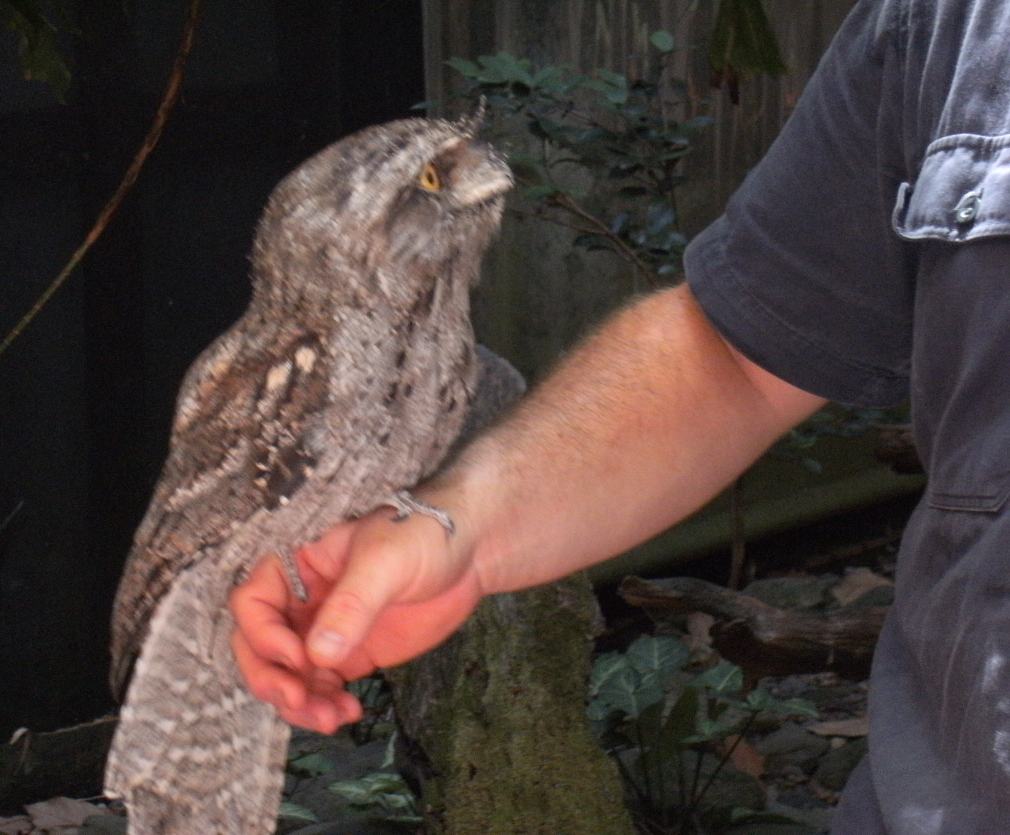When I was an undergraduate a joke about wide-mouthed frogs went the rounds…
Frog mouths are quite interesting, actually. Look into that gape & you’ll see a tongue (which is rooted at the front of the mouth, allowing it a greater forward reach). Back of the tongue is the glottis, opening into the trachea, & behind it the entrance to the oesophagus (showing, yet again, that if life was designed then the designer did a fairly poor job of it – having the airway & food passage cross over in the back of the throat is not really a good thing…). And on either side, in from the jaw joint, are the openings to the eustachian tubes that link the throat & inner ear. Another thing I find fascinating is that if you look at the roof of a frog’s mouth, you’ll see two bulges that mark the underside of the eyeballs. (Once a zoologist, always a zoologist…)
But this post is about another type of frog mouth altogether. Or, to be correct, a frogmouth:

This is a Papuan frogmouth – we saw a pair of these lovely little birds at the Habitat in Port Douglas. They might look vaguely owl-like, but frogmouths are only distantly related to owls. Their feet are smalled & weaker, and while they’ve got good night vision their eyes aren’t as big as those of an owl. Frogmouths are usually nocturnal, but the two we saw were sitting amiably in a corner of the ‘breakfast with the birds’ area, & in fact we encountered them on our way through to the savannah habitat after a most excellent breakfast (with the birds – if you go there, watch out for the ibis as it’ll pinch unguarded sausages!). They were quite tame & one was happy to hop onto the keeper’s arm – you can see those little toes, quite unlike an owl’s talons.

As the name suggests, a frogmouth’s mouth has quite a wide gape, Their main food is insects but apparently they’ll also take rodents & small lizards, swooping down silently to catch their prey. You can see in the photos that a frogmouth’s plumage has a soft, almost indistinct look to it – & it’s not because my photos are blurry! The ‘soft’ structure of owl feathers apparently underlies the typically silent flight of an owl (such as our own morepork), & I wonder if the same principle is operating in the frogmouths. And in the daytime, that fuzzy, indistinct plumage would provide excellent camouflage while frogmouths sleep in their roosts.
We saw a lot of bird species at the Habitati, but I think overall the frogmouths were my favourites – they were such engaging little things 🙂

herr doktor bimler says:
quite unlike an owl’s talons.
Well of course they’re different. If you had been paying attention while reading Pratchett books, you would recall that the forward-facing toes are pounces, and only the backward toes are talons.
a frogmouth’s plumage has a soft, almost indistinct look to it – & it’s not because my photos are blurry!
I had assumed that someone had done a poor job of Photoshopping.
Alison Campbell says:
Unkind, unkind 🙂